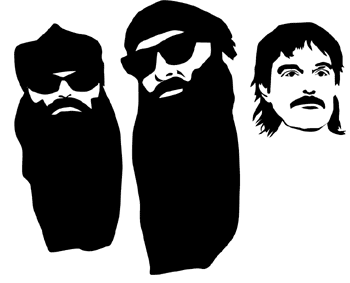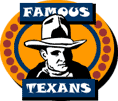
 ZZ Top
ZZ Top
|

 ZZ Top
ZZ Top
"He's our kind of guy." -- Frank Beard to Billy
Gibbons after Beard introduced himself to Dusty Hill in a bar. Hill passed out drunk
before returning Beard's greeting.--1969
Best known for: Classic rock trio
known for its Texas heritage, bearded, haggard look, reclusive mystique, hard-nosed
business tactics, and blues-rock sound.
Born: ZZ Top (aka, That Little ol' Band from Texas): 1969; Billy F. Gibbons (guitar): Houston, September 16, 1949; Dusty Hill (bass): Dallas, May 19, 1949; Frank Beard (drums): Dallas, June 11, 1949; Bill Mack Ham (manager): Waxahachie, 1937.
Family: Billy Gibbons, the son of a financially well-off family living in the Tanglewood suburb of Houston, never married. Dusty Hill is divorced with a college-age daughter. Frank Beard is married and has two twin boys and a daughter who reportedly goes to college in Houston and will be part of the University class of 2001.
Education: While growing up in suburban Houston, Gibbons learned about R&B music from his family's maid, who was African-American.
Career: Guitarist Billy Gibbons met his future manager, Waxahachie native Bill Mack Ham, backstage at a Doors concert in Houston in 1967. Gibbons' band at the time, the Moving Sidewalks, had a local hit with the song "99th Floor." They soon opened on the Doors' Texas tour. After later opening for the Jimi Hendrix Experience, Hendrix named Gibbons his favorite guitar player during an appearance on "The Tonight Show With Johnny Carson." The Sidewalks broke up and Gibbons and Ham contracted to form a new band.
After a few false starts with other musicians, the Gibbons-Hill-Beard version of ZZ Top was founded in 1969. According to Gibbons, the name came from one or more of the following: the two brands of rolling-paper, Zig-Zag and Top, a tribute to blues legend Z.Z. Hill, and/or Gibbons seeing the two words running together on a dilapidated bill board. Hill and Beard had been members of a Dallas band called American Blues.
The trio spent its first few years playing mostly regional concerts. Ham's bosses, Houston record producer Pappy Daily and family, cut a deal with him to finance "ZZ Top's First Album" (1970). Five other records followed on the London Records label. The third album, "Tres Hombres" (1973), brought them national attention. Its hit song "La Grange," about a whorehouse, was allegedly based on John Lee Hooker's "Boogie Chillen." It is still the band's signature riff tune. Also included was "Beer Drinkers & Hell Raisers," the would-be anthem.
In an event that tried to be a rock-style Willie Nelson Picnic, the group was the featured headliner in the "Rompin' and Stompin' Barndance and Barbecue," held in Austin on Labor Day, September 1, 1974. Appearing with them before a crowd of 80,000 was San Francisco legend Bill Graham, Santana, Joe Cocker and Bad Company making its U.S. debut. This was ZZ Top's first concert in which they were seen as more than just a Texas act. It was the biggest concert in Austin's history, and the last to be held in Memorial Stadium on the University of Texas Campus for another twenty years. The stadium had been trashed by concert-goers, who had suffered from the heat and lack of food, water and toilets.
The year-and-a-half-long Worldwide Texas Tour, with stage props like haystacks, ranch tools and Longhorn cattle, began in 1975. It featured songs from "Tres Hombres" and "Fandango," their fourth album. Although their concert earnings were now in the tens of millions, by the end of the tour the group was exhausted. They took a break that ended up lasting three years. Manager Bill Ham stayed busy, however, shrewdly negotiating a lucrative recording contract with Warner Brothers that is still talked about in the music business. Their next two albums, "Deguello" and "El Loco," were well received with hits like "Cheap Sunglasses" and "Tube Snake Boogie."
The next album, "Eliminator," featuring musically controversial electronic instruments, debuted ZZ Tops biggest hits, "Legs" and "Sharp-Dressed man." The synthesizers and drum machines caused controversy in other ways as well. According to former roadie David Blayney in his book, "Sharp Dressed Men," sound engineer Linden Hudson co-wrote much of the material on the album as a live-in high-tech music teacher to Beard and Gibbons. Hudson claims that in addition to not getting songwriting credit, Ham worked to cover up his contributions to the album. Despite continued denials by the band, it settled a five-year legal battle with Hudson, paying him $600,000 after he allegedly proved he held the copyright on the song "Thug." Another copyright suit was brought by a co-writer of John Lee Hooker's "Boogie Chillen," the alleged basis of "La Grange." That case was settled and sealed. The group's eighth album, "Afterburner," with its continued use of synthesizers, became a worldwide smash hit.
Until MTV came along in the '80s, ZZ Top had declined all offers for TV appearances. Their first video, "Gimme All Your Lovin'," set the style for follow-ups "Legs" and "Sharp-Dressed man." The addition of videos took the band's famous mystique and popularity to an all-time high.
In 1981, ZZ Top joined a diverse group, organized by art patron and civic leader Marilyn Lubetkin and including such philanthropists as Dominique de Menil, to donate money to purchase J.D. McKissack's Orange Show from his heir. The Orange Show, an open-air, multimedia sculptural installation dedicated to the orange, is Texas' leading example of an art form called "folk art environment." For their support of the blues and an art form, the band was given a piece of wood from Muddy Waters' shack in Clarksdale, Mississippi. They had it made into a guitar, named it the "Muddywood," and sent it on a tour to raise funds for the Delta Blues Museum.
By 1990, the band had sold 50 million records. Tragedy struck in 1991 when Ham's wife, Cecile, was murdered. A 23-year-old man on parole with three prior convictions strangled her for her car so he wouldn't have to walk to his halfway house. In spite of hard times personally, ZZ Top's 1996 album, "Rythmeen" was considered one of their best. Gibbons called it the "first pure trio record of our career," because only the three of them played on it. That return to an earlier sound, made more pure and raw, continued on their 1999 album, "XXX," which celebrates the band's thirtieth anniversary. At the turn of the century, ZZ Top was the only rock group with its original members after three decades.
Sources: The Official ZZ Top Web Site http://www.zztop.com; The Little ol' Web Page from Texas, http://www.mcs.net/~zztop/; Chris Riemenschneider, "ZZ Top: Thirty-odd years of lawsuits, legs and a shack outside La Grange," XLent magazine, December 16, 1999 (weekly tabloid supplement to The Austin American-Statesman), pp 30-33, 60; Kendall Curlee, "McKissack, Jefferson Davis," http://www.tshaonline.org/handbook/online/articles/view/MM/fmcdb.html, "Orange Show," http://www.tshaonline.org/handbook/online/articles/view/OO/lio1.html, The Handbook of Texas Online; Bertelsmann Music Group Ultimate Band List, ZZ Top Biography, http://www.ubl.com/ubl_artist.asp?artistid=001107.